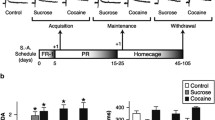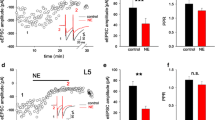Abstract
It has been suggested that behavioral methamphetamine sensitization involves changes in cortical excitatory synaptic inputs to neostriatal (Str) projection neurons. To test this, we performed blind whole-cell recording of medium spiny neurons in Str slice preparations. In Str neurons of naive rats, the amplitude of the subcortical white matter stimulation-induced N-methyl-D-aspartate receptor-mediated excitatory postsynaptic potentials (NMDA-EPSPs) was decreased upon hyperpolarization, owing to the voltage-dependent Mg2+ blockade of NMDA receptor channels. In contrast, the amplitude of the NMDA-EPSPs in Str neurons of rats undergoing methamphetamine withdrawal (MW) did not show the Mg2+ blockade and was nearly voltage independent over the membrane potential range of –70 to –110 mV. Application of the specific protein kinase C (PKC) activator, phorbol 12, 13-DL-acetate, blocked the voltagedependent Mg2+ blockade of NMDA receptor channels in Str neurons of naive rats. Application of the specific activator of cAMP-dependent protein kinase A (PKA), Sp-cAMPS-triethylamine salt, increased the amplitude of the NMDA receptor-mediated EPSPs at the rest but not at hyperpolarized potentials. Coapplication of the PKC and PKA activators yielded NMDA-EPSPs similar to those seen in Str neurons of MW rats. In Str slices of naive rats, tetanic subcortical white matter stimulation induced long-term depression of field potentials. In Str slices treated with the PKC and/or PKA, the same stimulation induced long-term potentiation of field potentials similar to those observed in slices obtained from MW rats. These results suggest that the enhancement of the NMDA receptor-mediated corticostriatal synaptic transmission plays an important role in behavioral methamphetamine sensitization. This enhancement is probably associated with phosphorylation of NMDA receptors mediated by the simultaneous activation of PKC and PKA.
Similar content being viewed by others
Abbreviations
- AMPA :
-
α-Amino-3-hydroxy-5-methyl-4- isoxazolepropionate
- BMI :
-
Bicuculline methiodide
- CPP :
-
3-(2-Carboxypiperzin-4-yl)-propyl-1-phosphonic acid
- DA :
-
Dopamine
- DPSPs :
-
Depolarizing postsynaptic potentials
- EPSPs :
-
Excitatory post synaptic potentials
- KA :
-
Kainate
- LTD :
-
Long-term depression
- LTP :
-
Long-term potentiation
- MW :
-
Methamphetamine withdrawal
- NBQX :
-
3-Dihydroxy-6-nitro-7-sulfamonybenzo[f]quinoxaline
- NMDA :
-
N-Methyl-D-aspartate
- PDA :
-
Phorbol 12, 13-DL-acetate
- PKA :
-
Cyclic adenosine monophosphate-dependent protein kinase
- PKC :
-
Protein kinase C
- Rp-cAMPS :
-
Rp-cAMPS-triethylamine salt
- Sp-cAMPS :
-
Sp-cAMPS-triethylamine salt
- Str :
-
Neostriatum
Author information
Authors and Affiliations
Corresponding author
Rights and permissions
About this article
Cite this article
Moriguchi, S., Watanabe, S., Kita, H. et al. Enhancement of N-methyl-D-aspartate receptor-mediated excitatory postsynaptic potentials in the neostriatum after methamphetamine sensitization. Exp Brain Res 144, 238–246 (2002). https://doi.org/10.1007/s00221-002-1039-3
Received:
Accepted:
Published:
Issue Date:
DOI: https://doi.org/10.1007/s00221-002-1039-3




